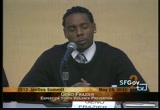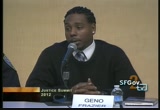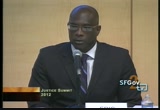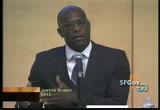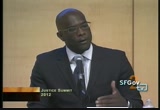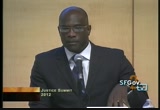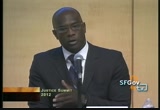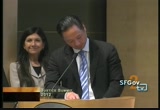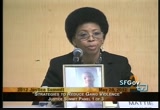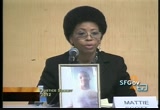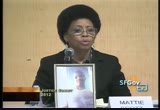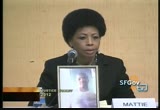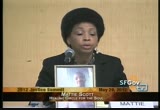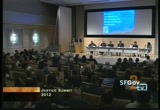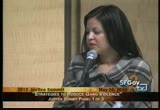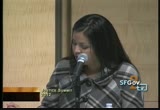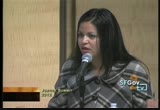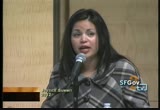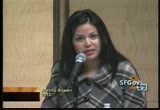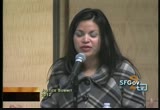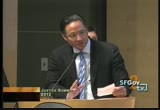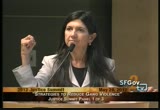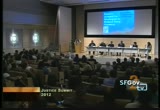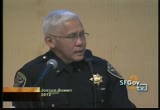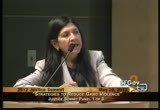tv [untitled] December 4, 2012 1:00am-1:30am PST
1:00 am
as being part of a gang. the term "gang" is manifested through the media, and law enforcement for numbers. it was more of a community. i did not go to school and meet somebody. i lived on this block and this is where my grandmother's house was, or i was born and raised. what people may see on tv was at my front door. the killing and the dope dealing. it was right there. this was a community list of people, we just grew up together. there were no handouts and no
1:01 am
one told us how to conduct ourselves. and tell us what to wear. someone could have a school fight, and we may be at the mall, and see the person we have a fight with. the army and navy have their bar fights. i did not see this as being a game, or a community. supporting each other, this may have been in a negative way. i did not have a stable household. many of them do not of their fathers are, where their father is dead. in their return, the block i
1:02 am
gave up -- this is who i looked up to. he had a notorious reputation. there was the violence and in return, we had the pros and cons for that. a lot of people would mess with me because of who my father was -- to my brother was. they became my enemies. it was not a choice. this is just how was. let's go get him. and it comes to the place, you get tired of running.
1:03 am
i did not see this as being wrong. what people defined as a gang, that must be a gang member right there. i have tattoos on my arm and neck and hand, and none of them are getting associated. they all tell personal story in my life. somebody would say that this is a gang member. there would be the artistic side. i think that this comes to a place where there has to be a level of understanding. they have the school system and
1:04 am
the politicians. everyone plays a part. [applause] >> you have worked as a police officer -- and now you're the prosecutor. you now prosecute all of the gang cases. what is your >> imagine you are 21, you are from mississippi, going through the police academy. it is 1989 and you are now working in los angeles. after being a patrol officer for just a few months, you are placed on gang detail. you have arrested a youth. instead of taking him to jail,
1:05 am
you taken to his mother. the mother says, can you make him more afraid of you that of the gang members? the academy does not prepare you for that. i take that experience and i realized in the gang environment, most of these youths are coming from single- family households. in the area where the gang violence is most prevalent, great citizens of the community, 99% of those citizens are afraid. as a prosecutor, i take this experience and figure out how i want to enforce gang violence, especially in san francisco. i break it down into three categories. you have the individual who is not fully immersed in the gang lifestyle. he is just an associate comment just hanging out.
1:06 am
-- associates, just hanging out. for that individual, we try to work with community-based programs. i've met with dcyf, the african- american steering committee, people haven't been in this violence and i say to them, what can -- people have been in this violence, and i say to them, what can we do to make sure if this individual does not go to prison? for that individual, we try to find a way to keep him out of the prison sentence. then you have the second individual, the individual who does crimes not for economic means, but for someone who has tried for that individual, we ho have consequences.
1:07 am
however, it does not mean that we have to enforce his prison sentence to the maximum of the law. we have a step program, which increases the amount of time you can go to a prison ford -- prison. for a home invasion, or a carjacking, or shooting into a car or house, you cannot 15 to life. for a regular felony, you can add five years. for that individual, we do not always seek to add that extra 10 years. we hope that person realizes, you almost spend the rest of your life in prison. it is up to you to see what you were going to do with that. and then we have the third group. they're committing the most violent crimes. the individuals that come together as a force, they are enforcing their will on a
1:08 am
community in the bayview, western addition, the mission. those individuals are dressed in a different way. -- addressed in a different way. we will do an indictment. the fed will do the same thing, they will indict maybe 15, 20 dain members. it is our hope that we have taken a group of individuals out of the community to protect the younger individuals. indictment that we did with 10 gang members in bayview. we only went after the 10 most violent gang members. the ones committing murders, robberies. within their gangs, there was another subset of the individuals doing burglaries. those are not the individuals we went after. we went after the most violent ones. by getting of the most violent ones, what happens there was
1:09 am
below of homicide, robbery is entailed -- and a lull in retaliatory shootings. what has to be done, you have to find a way to address that lull when it occurs. when he to find a way to have intervention when certain of the most violent members are taken off the streets. we look at the context of the individual, the external factors, and we try to find the appropriate remedy. [applause] >> you started an organization that helps parents who have suffered the death of their child or children by violence. what made evaded you to do this? >> but what motivated you to do
1:10 am
this? >> good morning, so glad to be here. i want to thank you for inviting me to this panel. giving honor to god for allowing me to be here today to do this work. if it was not for him, i could not be here. i do this work, at it is not just me, it is over 300 families that we represent in san francisco alone. the reason why i do this. i do it because my son was murdered in the western addition july 17, 1996, a day before his oldest son, at the age of 5, his birthday was the next day.
1:11 am
this is the reason why i do it. 300 family is, over 350 families in san francisco alone that i know personally, that are members of the healing circle, cases have not been solved. she lost three sons to gun violence in the month of august. that is the reason why i do. i do it because betty cooper lost two sons in the bay view to violence. it still remains unsolved. in 1996, when my son was killed, 96 homicides in san francisco. everybody seemed to think that it was just another day in my community. no one knew the pain i was suffering. no one knew when i was going
1:12 am
through. no one knew how this affected my family, my children, my community. no one seemed to care. i do it because what happened in columbine should have happened in my neighborhood, and it did not. there was no one there for me when this happened to me. [applause] there were no counselors, and nobody come into my house to ask me questions about what happened. the already labeled my son in the papers as a gang member. they labeled him as a drug dealer. no be had came to me -- no media came to me to ask me about my child. the people in my community seamen visible -- seemed invisible, and that seems unfair. i do because i want to see
1:13 am
justice. i want to look at the person who killed my son and asked him why. why did you kill my son? what was so -- what did he do that allow you to shoot him point blank with four bullets in the face? what would make you do such a thing? i want to meet the individual, to let him know i have already forgiven you. if i had not for giving you, i would not be here today. i have to forgive you, but i want to know why. why do i want to know why? i want to get you killed, too. kurds people -- hurt people hurt people. apparently, you are hurting. you had to be hurting that night to shoot my son in the face. you knew him, you ate at my
1:14 am
house, you spend time together. i want to know why you killed my son. i want to know why. i want to know why the community did not step up. everybody was present. i want to know why came to say who did it. i want answers. like all the 300 mothers that we represent in the healing circle, they ask the same question. i want to know why along with the over 30,000 unsolved homicides since the 1990's. over 30,000. over 30,000 unsolved. that is over 30,000 families that i represent. i want to know why.
1:15 am
we are the healing circle and we believe in healing people. we go inside of san quentin, we go inside of the county jail, the juvenile justice system. all entities -- the whole family is incarcerated. we want to kill the whole family. that is why we go when -- we want to heal the whole family. that is why we go in. we believe in empathy, we believe this violence is a learned behavior. restored of justice does work. -- restorative justice does
1:16 am
work. [applause] >> elizabeth, you have been on both sides. as a teenager, you were a recipient of services. today, you are working in youth development. what do you think the answer is in reducing gang violence? >> i want to give thanks for another day here and an opportunity to share this space with everybody. all of the beautiful courage that it takes to be up here. a lot of energy to the healing circle as well. as a juvenile, i was in juvenile hall and i went through that whole system myself. i have worked with tattoo removal, i went to other development programs. through personal experience and
1:17 am
being raised by a single mom and being proud of my dad imprisoned and now pursuing my education, i would say there is not one answer. the answer is that there is not an answer. you have brought about by bringing this conversation forum. it is not just law enforcement perspective, it is not just the community-based perspective, it is not just the research perspective, it is a multi- layered approach. first and foremost, we do have to consider meeting youth where they are act. we are talking about perpetrators of violence or what not or system involved or involved in gangs, we have to meet them where they are at. pain and hurt produces more hurt, right?
1:18 am
what is fundamental it is addressing back pain -- addressing that pain. not looking at folks in a punitive way and saying, this guy is notorious, we have to lock him up. that person is hurting. he might have been abused, you know. first and foremost, we need to meet that individual's needs. i am pursuing a master's in social work. i have that lens. we need to heal our communities and take those answers upon ourselves. everybody has already -- we sure this in perspective, but definitely, we need to create community anchored solutions.
1:19 am
that involves a discourse with policy makers. as people of color, we need to be accountable and to be positive role models. greek them on the bus and not be scared of art -- greet them on the bus and not be scared of our own people. we stereotype ourselves and we are price ourselves. we need to be accountable and we need to respect each other and what with integrity. those are our kids. that is our community. we need to be those role models for those kids. if we lock ourselves up in the ivory tower, in the institutions, we are not providing -- what are we providing? we are not providing those alternatives. yes, a lot of the work that community agencies -- they are out there.
1:20 am
you do not have to be a community based agency to be a positive role model, right? a smile goes a long way, you know? if a kid -- just because of how he dressed and people demonstrate that they are scared of him, what do you think he is going to do? that is one of the different approaches. i also think it is important to be flexible as community workers or law enforcement. we need to be flexible because things change. there is not just one solution. kids might take 10 steps forward. they might make such significant progress, and then something goes down. something goes down and they take eight steps back. we need to be able to be flexible with them and be there through that process. and not to say, i am not working
1:21 am
with you anymore because you let me down. that is really important as well, not to be rigid. collaborations are very important as well. if we are talking about bringing everybody to the table to develop solutions, youth should have the same importance as the district supervisor, as the police enforcement officer, as the executive director. through that, we build a real communities. i have respect for our brother over here and respect for my sister over there. you develop that accountability and integrity billet -- and integrity amongst one another. we are able to express ourselves and develop real solutions, especially in the time where the budgets are cut left and right. the only thing we have left is our human relationships. honestly, we know health and
1:22 am
human services are the first things to get slashed. by developing those relationships with each other, i think we will go a long way. partnerships with local business, i know that that is really important. instead of shutting their kids or monitoring tm as the balkan, why don't you offer them a job? -- model train them as they walked in, why don't you offer them eight -- monitoring and the them as they walked in, why don't you offer them a job? [applause] >> i will ask the professor to ask some specific questions. and then we will get to your questions in about eight or nine minutes. i will ask you to keep your
1:23 am
response is brief. >> ok, you will have to bear with me. i am going to go off script for 30 seconds. there is a person in the audience, and i meant to mention her during my keynote. it is someone that you all should try to talk to during a break or during lunch because someone like her should be on this panel. one person missing. it is a public defender. this is someone who worked as a public defender for 19 years in los angeles. she is now director of legal services. now i'm going to embarrass her. her name is ellie miller. there she is. [applause] public defenders are legal ministers.
1:24 am
you are. you are part of this picture. ok. i will go back to what i was supposed to be doing, forgive me. i am going to -- we have heard everybody's contribution. now i want to talk about what is working and what is not working. i am going to ask each of the members to speak the truth to one another. let me direct some early remarks. you have suffered unimaginable pain. i will make an assumption that i can speak for the audience in singing, cannot imagine what would be like to be is a child. from that pain, from your community organizing, what do you say to the commander? it is not 1996 any more. what is going on? what do you say to him? what does he say to you?
1:25 am
i will ask you to keep the remarks brief. commander, i will give you a chance to respond. you are hearing about all these things, what is your reaction? >> there needs to be more police sensitivity training in sfpd when it comes to victims of violence. often times, many of their parents that are on the scene when this happens, the majority of them gets arrested and they do not understand the crime scene. all they see is their child laying there in a pool of blood. all they want to do is get to that child, not knowing they may damage a crime scene. i would like to see, commander, more sensitivity training with the police department. learning about the victim's family, we are there, to when it
1:26 am
happens. the first thing we want to do is get to that family, to prevent any further violence. i would like to see that happen. >> commander? >> we do have sensitivity training. 32 hours of that better police academy. never, you are correct. it is unacceptable for -- however, you are correct. it is unacceptable for any parent to be rested at the scene. -- and arrested at the scene. i have never seen that happen and i have never heard of that. i would say they are perhaps being pulled away for their own good.
1:27 am
they are being assisted. if they are being put into a police radio car, they may be taken to another location. family members that can help them. i can assure them that i've never seen anyone be arrested at the scene like that. >> we want to have a conversation. i am going to turn around to mr. fleming. we will go back and forth. what would you say -- what role can he play, talked about the three groups of individuals. you mentioned that first group. on the edge. and he mentioned a second group, the group that would have step- by-step sentencing.
1:28 am
is there anywhere for someone's skill set to assist you in that effort? >> i like the question and i will tell you why. i think the groups working with the youth are doing the best we can -- the best they can. sometimes, you need tough love. they need to set guidelines and make them understand that if they do not go according to the program, they will be out of the program. one thing i like to see, when that individual -- the individual gets arrested and i will decide whether or not to file charges. a lot of times, i do not file charges. that person is released from jail the second day and then he is back in the community. there should be somewhere within the police department for someone like jeremy to meet with that person the day he is being
1:29 am
released. i think that would be a very effective means for him to intervene. in dealing with the violent us youth, they need to make them understand that they have done something, there will be repercussions, there will be consequences. they will have to serve their time, but not get lost in the shuffle. prison can have two or facts. it can make someone want to be more productive member of society or they can become more integrated into the gang lifestyle. these individuals can go in and
138 Views
IN COLLECTIONS
SFGTV2: San Francisco Government Television Television Archive
Television Archive  Television Archive News Search Service
Television Archive News Search Service 
Uploaded by TV Archive on

 Live Music Archive
Live Music Archive Librivox Free Audio
Librivox Free Audio Metropolitan Museum
Metropolitan Museum Cleveland Museum of Art
Cleveland Museum of Art Internet Arcade
Internet Arcade Console Living Room
Console Living Room Books to Borrow
Books to Borrow Open Library
Open Library TV News
TV News Understanding 9/11
Understanding 9/11